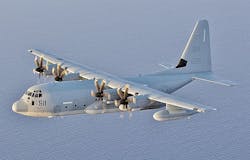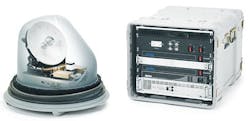Marines look to ViaSat for hatch-mount SATCOM antenna for streaming video aboard KC-130J aircraft
QUANTICO MARINE BASE, Va., 24 Feb. 2015. U.S. Marine Corps aviation experts needed hatch-mount satellite communications (SATCOM) antennas for the KC-130J Super Hercules utility turboprop aircraft. They found their solution from ViaSat Inc. in Carlsbad, Calif.
Officials of the Marine Corps Systems Command at Quantico Marine Base, Va., have announced their intention to award a $6.90 million contract to ViaSat for a hatch-mounted satellite antenna for the KC-130J four-engine cargo and utility aircraft.
The contract, which has yet to be officially awarded, calls for ViaSat to provide SATCOM antennas for the KC-130J, as well as ViaSat's Yonder SATCOM network access, ancillary equipment, and sustainment.
ViaSat produces the VMT-1220HM two-way broadband Ku- and Ka-band antenna that can provide the Marine Corps KC-130J with real-time video and SATCOM on the move on intelligence, surveillance, and reconnaissance (ISR) missions.
The Lockheed Martin KC-130J provides the Marine Corps with global reach and rapid deployability. It helps the Marines deliver infantry warfighters, fuel, and cargo, where needed.
The ViaSat VMT-1220HM SATCOM antenna is a self-contained airborne satellite terminal for high-speed Internet-protocol communications-on-the- move. The antenna and ViaSat’s Yonder mobile broadband service can enable KC-130J operators to send live, full-motion high-definition video over the horizon, make phone calls, conduct video conferences, access classified networks, and perform mission-critical communications while in flight.
The VMT-1220HM features a roll-on/roll-off design for simple installation and rapid integration. It fits into the KC-130J escape hatch while retaining the hatch's use as an emergency exit. The SATCOM terminal can deliver streaming data rates as fast as 4 megabits per second with a 12-inch antenna, upgradable to 10-megabit-per-second.
The VMT-1220HM can assist the Marine Corps KC-130J perform ISR missions, as well as command, control, communications; VIP transport; search and rescue; anti-piracy; electronic warfare; telemedicine; and aerial refueling.
The SATCOM terminal has Type 1 encryption; Mitigates adjacent satellite interference with spread spectrum waveforms; can be fitted to different C-130 aircraft; offers satellite tracking with inertial reference unit; and high-capacity coverage available over key regions like the Middle East, Southwest Asia, Europe, and the U.S.
The KC-130J is a tactical tanker and transport aircraft that stretches more than 90 feet in length and 130 feet from wing to wing to enable the Marine Corps to resupply austere battle zones, provide battlefield illumination, insert ground troops, and perform medical evacuation operations.
The aircraft also can perform aerial refueling for Marine Corps helicopters and other aircraft. The KC-130J also provides for rapid ground refueling of helicopters, vehicles, and fuel caches.
The Marines are awarding the contract to ViaSat sole-source because the company is the only vendor that can provide a flight-certified Ku-Band hatch-mounted SATCOM that can meet Marine Corps requirements for the KC-130J, Marine Corps officials say.
For more information contact ViaSat online at www.viasat.com, or the Marine Corps Systems Command at www.marcorsyscom.marines.mil.


